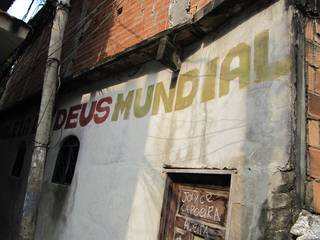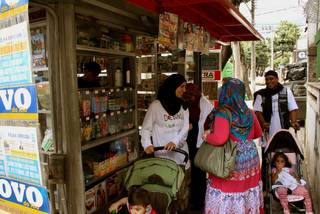Celebrated in a bossa nova (“new trend”) song, the Copacabana has become a popular destination for tourists from across the globe. Seventy hotels crowd the four kilometer-long promenade, beyond which the world’s most famous shoreline melts into the sea. Once a year, however, on New Year’s Eve, it is the Cariocas themselves, the residents of Rio de Janeiro, who undertake a pilgrimage here and transform the beach into a sacrificial altar. Even during the day one must take care not to fall into one of the many deep holes dug in the sand. They contain burning candles and the goods which are to be offered to the goddess of the ocean in the dead of night: grapes, cigarettes, coconut milk, champagne, liqueurs, and much more besides. During the night, with the temperature still over thirty degrees centigrade, some 2 million people gather on the beach. Their joyful and alcohol-fueled party only subsides when the procession of the priestesses of Candomblé starts to move off. To the strains of monotone chanting, these holy women proceed initially along the seafront, the Avenida Atlântica, and then head towards the sea. There boats are lowered into the water, laden with the gifts and flowers which are to be offered up to the life-giving elements. According to popular legend, offering up a white flower means your wish will be fulfilled. Days later the beach is still strewn with flowers which the revelers sacrificed to the sea during this night.
Apart from the carnival, which is based on the church calendar and which ends on Ash Wednesday, Rio de Janeiro’s second best-known public festival is also religiously motivated— albeit inspired by another, namely, a polytheistic tradition. In common with half of the Brazilian population, Iemanjá, the goddess of the ocean, who is being venerated here, hails from Africa. In the Nigerian Yoruba cults, in which the roots of the Afro-American Voodoo are to be found, she is worshiped as a river goddess, whereas in Brazil she is revered as the goddess of the ocean and the mother of all living things. The New Year’s festival on the Copacabana serves as an example of cultural syncretism, which has shaped Rio de Janeiro down to its roots. Even the name “Copacabana” itself attests to its far-reaching spatial and temporal cultural synthesis. For it has traveled across the continent to Rio: Copacabana is the name of a peninsula in Lake Titicaca, which lies in the high plains of the Bolivian Andes. This was not only a religious site in the Andes, but also one of the most sacred sites in Latin America per se. Even before the Incas, who ruled here from the fourteenth century onwards, Copacabana was regarded as the site of creation and the center of the world. The Catholic colonialists of the seventeenth century also seem to have profited from this religiously charged site. The god of the indigenous sun cult was transformed into the Nossa Senhora de Copacabana, who, in addition to the Virgen de Guadalupe, is South America’s most important Marian figure. Peruvian smugglers are said to have smuggled a portrait of the goddess to Rio, although when exactly is not known. By the eighteenth century at the latest, her cult was established here and the beach was named after her. So who are the Cariocas really paying homage to on New Year’s Eve? Are they drawing on Latin America’s indigenous tradition or on the city’s African heritage? Yet it is not only the thousands of magic flowers strewn into the sea on New Year’s Eve which are white; for white is also the prescribed color of the apparel to be worn on this night. Accordingly, it is traditional for the entire editorial department of Rio de Janeiro’s biggest-selling daily newspaper O Globo to wear white on December 31. This is not a profession of faith, but living folklore. In other respects these journalists have no affiliations to a religion, which until the abolition of slavery in 1888 was exclusively confined to the African slaves who were shipped to all parts of Brazil via Salvador de Bahia, the hub of the transatlantic slave trade.
Although today Candomblé is a recognized religion, it is practiced by a mere one-and-ahalf percent of the Brazilian population. Attracting a similarly small following is Umbanda, also an Afro-Brazilian cult. In so far as any religion plays a role in the demography of this increasingly atheist country, then it is Catholicism. Today, the only visible vestiges of the religious traditions which have helped to shape the city are these folkloric rituals. Nowadays, living religiosity can only be found elsewhere in Rio de Janeiro. Since the 1980s, the Pentecostal churches have benefited above all from the poverty which prevails in the favelas on the slopes of the city. Popular films such as Cidade de Deus (City of God) have used biblical metaphors to portray this part of the city as a godless wasteland, as a living hell. And it is from this poverty, which has fueled the organized drug gangs, that the Pentecostals recruit their congregation. The conversion to religion and the attendant hopes of a rebirth into a new and God-fearing existence seems to offer an alluring escape to drug dealers, addicts, or their womenfolk, who in their prayers seek salvation from the daily horror of their lives. “Crusaders” is how the Pentecostals themselves call their missionizing campaigns. They hold their services in the open air—preferably in areas where drug dealing
is rampant. However, they also spread the gospel via the television, with the second biggest channel in the country owned by a Pentecostal church. The current and rapid advance of this faith continues an old tradition in Rio. Here, syncretism has always ensured that the great religious narratives offer themselves as a solution to the social problems which have their roots in the endemic violence and poverty. The favelas (whose existence was not even acknowledged by the city administration until the 1940s) represent a relatively recent problem of this kind. And the Cariocas—be it the goddess of the ocean Iemanjá or the Nossa Senhora de Copacabana—have always been highly flexible on the issue of who to pray to or light a candle for.


